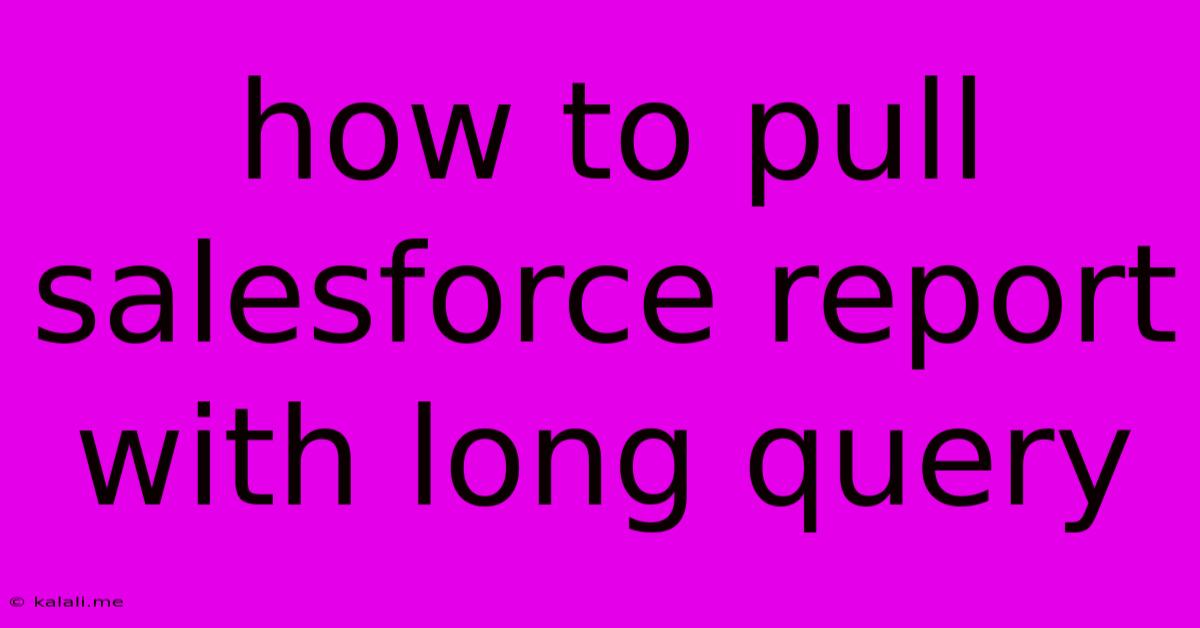How To Pull Salesforce Report With Long Query
Kalali
May 29, 2025 · 3 min read

Table of Contents
How to Pull Salesforce Reports with Long Queries: Optimizing Performance and Avoiding Timeouts
Salesforce reports are essential for data-driven decision-making, but complex queries can lead to performance issues and frustrating timeouts. This article explores strategies for optimizing your Salesforce report queries, even when dealing with extensive datasets and intricate filter criteria. We'll cover techniques to improve query efficiency, handle large data volumes, and troubleshoot common problems. By understanding these methods, you can effectively extract the insights you need from your Salesforce data, even with the most demanding queries.
Understanding Salesforce Report Query Limits
Before diving into optimization techniques, it's crucial to understand Salesforce's governor limits. These limits are in place to ensure system stability and prevent resource exhaustion. Exceeding these limits, especially with complex queries involving many records or complex joins, will result in errors or timeouts. Key limits to be aware of include:
- SOQL Query Row Limits: The maximum number of records a single SOQL query can return. This limit varies depending on your Salesforce edition and can be further impacted by factors like the complexity of the query.
- CPU Time Limits: Salesforce imposes limits on the amount of CPU time a single query can consume. Complex queries with numerous filters or aggregations can exceed this limit.
- Query Timeout: Even if a query doesn't hit CPU limits, it can still timeout if it takes too long to execute.
Optimizing Your Salesforce Reports for Long Queries
Pulling data efficiently from Salesforce requires a multi-pronged approach. Here are some crucial strategies:
1. Employ Efficient SOQL:
- Use Specific Filters: Avoid wildcard characters (%) unless absolutely necessary. Precise filtering dramatically improves query speed.
- Limit Fields: Only select the fields you need. Including unnecessary fields increases the amount of data processed, slowing down the query. Use the
SELECTclause judiciously. - Avoid
SELECT *: This is a major performance culprit. Explicitly list the required fields. - Optimize Joins: Use inner joins (
INNER JOIN) instead of outer joins (LEFT JOIN,RIGHT JOIN) whenever possible. Outer joins are significantly more resource-intensive. - Use Subqueries Sparingly: Subqueries can be slow. If possible, restructure your query to avoid them. Consider using semi-joins instead.
- Indexing: Ensure appropriate indexes are present on frequently queried fields. Proper indexing can dramatically improve query performance, especially with large datasets.
- Use Aggregate Functions: Utilize aggregate functions (e.g.,
SUM,AVG,COUNT) to reduce the amount of data returned, thus improving performance.
2. Leverage Salesforce Features:
- Summary Reports: For aggregated data, summary reports are often significantly faster than detailed reports.
- Report Types: Create custom report types to define the relationships between objects beforehand. This simplifies the SOQL generated by the report.
- Data Loading Tools: For extremely large datasets, consider using Salesforce's Data Loader or other bulk data loading tools. This allows for more efficient handling of vast amounts of information outside the typical report interface.
3. Troubleshooting and Debugging:
- Salesforce Debug Log: The debug log provides detailed information about query execution, helping you identify bottlenecks. Analyze the log to pinpoint slow parts of your query.
- Analyze Query Plan: While not directly accessible in the standard report interface, Salesforce’s developer tools provide ways to analyze the execution plan of your queries. This reveals how Salesforce processes your query and can highlight areas for improvement.
- Break Down Complex Queries: If a query is extremely complex, try breaking it down into smaller, more manageable queries. You can then combine the results programmatically or using other tools.
4. Consider Alternatives:
- Apex Data Retrieval: For extremely complex scenarios, consider writing Apex code to retrieve and manipulate the data. Apex gives you greater control and optimization possibilities.
- External Data Tools: For specific needs and data analysis, external business intelligence tools that integrate with Salesforce may be more suitable for handling large-scale data extraction and reporting.
By implementing these strategies, you can significantly improve the performance of your Salesforce reports, even when dealing with long and complex queries. Remember that optimization is an iterative process. Continuously monitor your reports' performance and refine your queries to ensure optimal efficiency.
Latest Posts
Latest Posts
-
How Many Watts Does A Portable Ac Use
May 30, 2025
-
How To Make A Redstone Repeater Loop
May 30, 2025
-
How To Tell What Key A Song Is In
May 30, 2025
-
Center Of Mass Versus Center Of Gravity
May 30, 2025
-
Can A Star Orbit A Planet
May 30, 2025
Related Post
Thank you for visiting our website which covers about How To Pull Salesforce Report With Long Query . We hope the information provided has been useful to you. Feel free to contact us if you have any questions or need further assistance. See you next time and don't miss to bookmark.